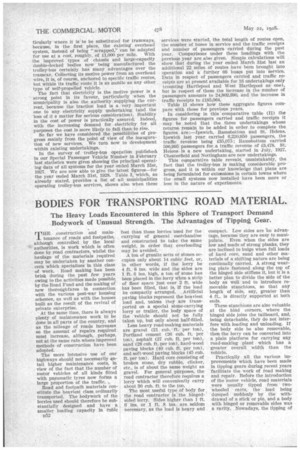THE PROGRESS AND PROSPECTS OF THE TROLLEY-BUS.
Page 125

Page 126

If you've noticed an error in this article please click here to report it so we can fix it.
Facts and Figures which Show that the Development has been Steady, if Slow, and that the Supplanting of the Tramcar Proceeds Relentlessly.
THERE exists at the present time considerable interest in the prospects of various forms of passenger transport under municipal ownership, and in this connection it is undoubtedly an attractive speculation to estimate the progressive possibilities of the trolley-bus. It may be useful for the purpose to consider briefly at the outset certain aspects of its history. During the past 20 years 50 local authorities have obtained the necessary statutory powers to operate railless systems of electric traction. Many of these powers were sought and obtained as a mere formality, the authorities at the time having no intention of exer cising them. In seven cases they have now been allowed to lapse, and of the 43 remaining 25 authorities have up to the present constructed systems. Here is the chronological order of their introduction:1911, two; 1912, two; 1913, two; 1914, one; 1919, one; 1920, one; 1921, one; 1922, one; 1923, two; 1924, two: 1925, three; 1926, three; 1927, four.
The Maidstone system, which was opened on the first of this mouth, also replaces tiainways-on the Banning route-about two miles in length. Ransom-, Sims and Jefferies 63-seater double-deckers are employed in this case.
The 16 authorized systems remaining and not yet commenced are in respect of the following authorities: Barrow-in-Furness, Bolton, Colchester, Croydon, Darwen, Lincoln, Lowestoft, Manchester, Northampton, Reading, Sheffield, Tynemouth, Wallasey, Walsall, West Bromwich and Worcester.
Accrington, Cleethorpes and Gloucester are applying for powers in the present Parliamentary session. From this brief review of powers authorized and exercised it is clear that, whilst the rate of progress was slow in the beginning, the trolley-bus is coming increasingly into use and is now employed, as will be seen in Table I, in a significant number of towns.
Uses for the Trolley-bus.
Generally speaking, the trolley-bus has been put into operation in substitution for tramways on routes in outlying suburbs where the traffic is light, when it has been possible to utilize and adapt the existing overhead system for the purpose. Now that local authorities in many parts of the country are, partly by reason of the large expenditure involved in the renewal of tram tracks, considering alternative transport systems, the advantages of the trolleybus from the municipal point of view will doubtless exercise some influence in its favour.
le IL
LE OF MUNICIPAL ERATI ON, 1920-28.
Total No. of Vehicles. Passengers Carried, Traffic Receipts.
£ 73 10,533,962 89,376 76 9,549,003 90,644
Every form of transport has its partisans, and by some the trolley-bus is looked upon as almost an ideal form of vehicle for municipal service, par ticularly wnere it is to be substituted for tramways, because, in the first place, the existing overhead system, instead of being " scrapped," can be adapted for use at a cost, roughly, of £1,000 per mile. With the improved types of chassis and large-capacity double-decked bodies now being manufactured the trolley-bus certainly has many advantages over the tramcar. Collecting its motive power from an overhead wire, it is, of course, anchored to specific traffic routes, but within its traffic route it is as mobile as any other type of self-propelled vehicle.
The fact that electricity is the motive power is a strong point in its favour, particularly when the Municipality is also the authority supplying the current, because the traction load is a very important one to any electricity supply. undertaking (and the loss of it a matter for serious consideration). Stability in the cost of power is practically assured. Indeed, with the increasing demand for electricity for all purposes the cost is more likely to fall than to rise. So far we have considered the possibilities of Progress mainly from the point of view of the inauguration of new services. We turn now to development within existing undertakings.
In the survey of trolley-bus operation published. in our Special Passenger Vehicle Number in February last statistics were given showing the principal operating data of all systems for the year ended March 31st, 1927. We are now able to give the• latest figures—for the year ended March 31st, 1928. Table I, which, as already stated, provides a list of all municipalities operating trolley-bus services, shows also when these services were started, the total length of routes open, the number of buses in service and the traffic receipts and number of passengers carried during the past year. Comparisons under these headings with the previous year are also given. Simple calculations will show that during the year ended March 31st last an additional 22 miles of routes have been brought into operation and a further 66 buses put into Service. Data in respect of passengers carried and traffic receipts are at present available for 16 undertakings only (counting Hartlepool and West Hartlepool as one), but in respect of these the increase in the number of passengers amounts to 24,802,390, and the increase in traffic receipts to £185,064.
Table II shows how these aggregate figures compare with those for previous years.
In considering in this comparative -table (II) the figures for passengers carried and traffic receipts it may be noted that the three undertakings whose returns remain to be added in order to complete the figures are :—Ipswich, Ramsbottom and St. Helens. Ipswich last year. carried 6,220,950 passengers, the traffic revenue being £35,075; Ramsbottom carried 596,995 passengers for..11 traffic revenue of £3,478. St: Helens is a new undertaking, started in July, 1927. Chesterfield and-Nottinghatu are new undertakings.
This &Imperative table reveals, unmistakably, the fact that the trolley-bus is making considerable progress, and it is within our knowledge that plans are being formulated for extensions in certain towns where the small systems now installed have been more or less in the nature of experiments.




















































































































































































































